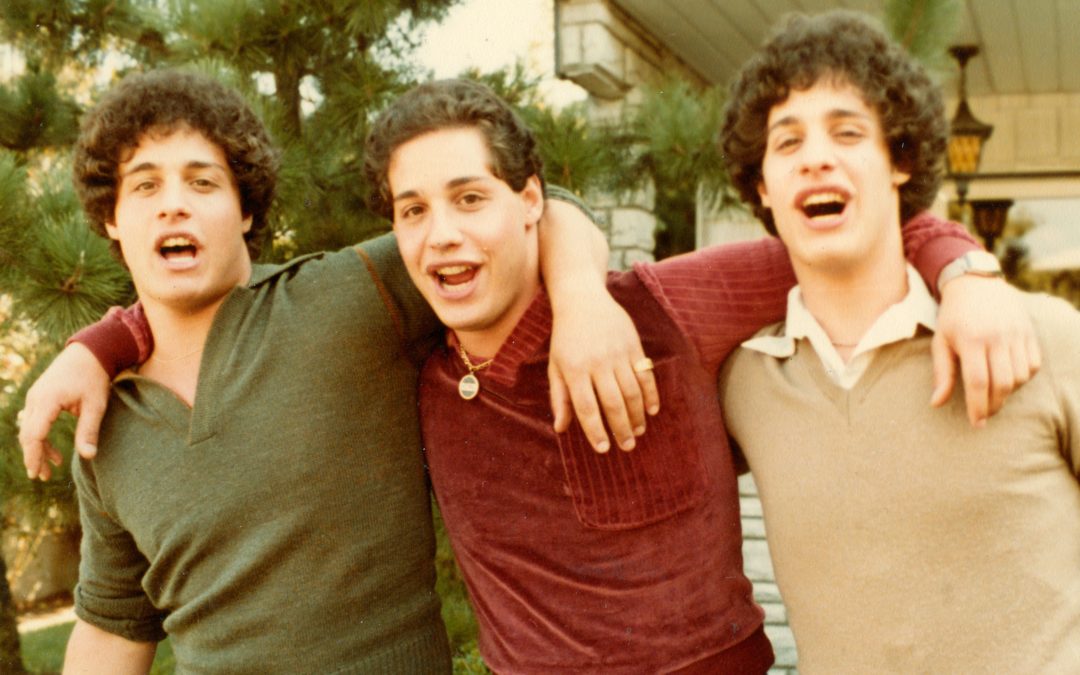Three Identical Strangers:
A Documentary
Winner, Special Jury Prize, Sundance Film Festival, 2018
–Review by Teri Hyrkas
The advertisement for Three Identical Strangers had so many superlatives surrounding the film’s title that my suspicions were aroused. How could any movie be that good? Nevertheless, the trailer was intriguing, so not long after the documentary was released in July, I found myself in the ticket line.
There is no way to review this movie without including spoilers, so stop reading here if you want to see the movie free and clear of unsolicited input.
Three Identical Strangers, directed by Tim Wardle, is a documentary about three brothers, triplets, who were given up for adoption. The boys were separated at six months of age when each child was successfully placed in an adoptive home. Although each boy knew early on that he was adopted, neither they nor their parents knew they were triplets until the boys found each other — crazily, happily, found each other by accident — when they were nineteen years old. Three Identical Strangers is a true story which Bobby Shafran, one of the triplets, said he would never have believed – if it hadn’t happened to him.
The triplets, Eddy Galland, David Kellman and Bobby Shafran, grew up near New York city within a hundred square miles of each other. When nineteen year-old Bobby arrived at a community college in a small town in upstate New York, a location new to him, the students on campus greeted him warmly, as if they were already his friends. Bobby was confused by this and a little upset at being mistaken for someone else. Then his dorm mate, Michael Domitz, almost fainted when Bobby walked over to introduce himself. After he recovered from the shock, Michael asked Bobby if he was adopted and what his date of birth was. When Bobby told him yes, he was adopted and his birth date was July 12, 1961, his roommate said, “I think you are a twin.”
That night Bobby and Michael drove one and a half hours to the home of Eddy Galland where the boys, obviously identical twins, met. The amazing news spread quickly. Over the next few days the story and pictures of the boys appeared in newspapers throughout the state of New York.
Another set of New York parents read the news story and saw the pictures of the boys. Their son, David Kellman, called the Galland home to say the he also was an adopted child born on July 12, 1961, and thought he might be a triplet. As David Kellman said in the documentary, “That’s when the story went from amazing to incredible.” Presently the identical triplets met, and once the national media got hold of pictures of the brothers and heard their story, the triplets became a sensation. Every major network talk show and all the celebrity magazines courted them – they were the darlings of the media.
Soon the brothers took an apartment together, lived life in tandem and started to think of themselves as a unit. Through family photographs and video clips, interviews with family members, friends, and journalists, director Tim Wardle captures the intense joy of the triplets as the young men come to know each other. Their love for each other, their exuberance and camaraderie seem to fly off the screen and carom off the theater walls. From all appearances this is a fairytale beginning of a wildly unlikely but truly happy family reunion — and for a season it is. But the story changes rather quickly from a fairytale to an unsettling mystery and there are hints of darker days to come.
In the 1980’s the brothers were enjoying their new found families, their fame and their popularity. They weren’t troubled by the unusual circumstances surrounding their adoptions — but their parents were furious. All six parents went together to Louise Wise Services, the preeminent adoption agency in New York for Jewish families and the organization which had arranged the adoptions for the triplets, to confront the agency’s top people. The parents asked probing questions, demanded answers, and initiated litigation but got nowhere. Their investigative efforts were stonewalled from every direction. They went back to their daily lives with more questions than answers about the boys’ adoptions.
Over time, the realities of life set in and in the 1990’s the triplets drifted apart. According to David’s Aunt Hedy, the brothers “belonged to each other,” but they lacked the ability to adjust to each other. “You learn how to adjust when you are a kid, but they did not learn how to do this.”
In 1995, just as the triplets faced devastating changes in their family, journalist Lawrence Wright published information on an ethically questionable study of twins. An adoption agency had, in the 1950’s and 1960’s, separated twins in early infancy, placed them in selected households, then conducted psychological testing regularly over the course of many years. The families were told that these studies were done to test the normal development of adopted children. The actual and secret purpose of the testing was to collect data to settle the contentious question of genetics and free will, or nature versus nurture, in twins. The name of the adoption facility involved in the secret study was Louise Wise Services, the agency which had separated and placed the triplets in their adoptive homes. As they became aware of this information, the brothers suddenly saw their separation and adoption for what it was: a science experiment. The remainder of the movie addresses this and other disturbing issues involving the triplets.
Three Identical Strangers is a movie that lives up to its hype. The astonishing and irresistible story of separated triplets being reunited is revealed to be only the first part of a complex and deeply troubling narrative. This remarkable documentary has earned the praise awarded it, and not only deserves its many accolades, but warrants the viewers’ close and careful attention as well.

